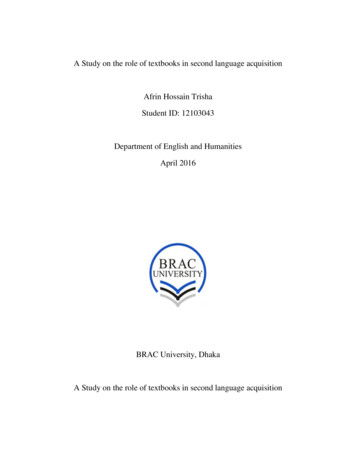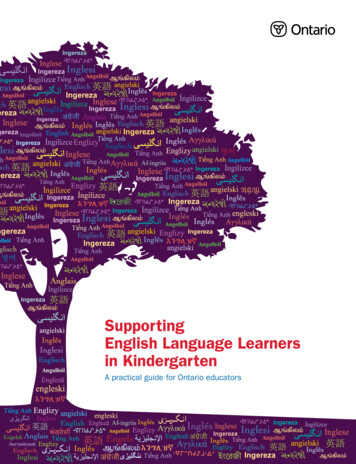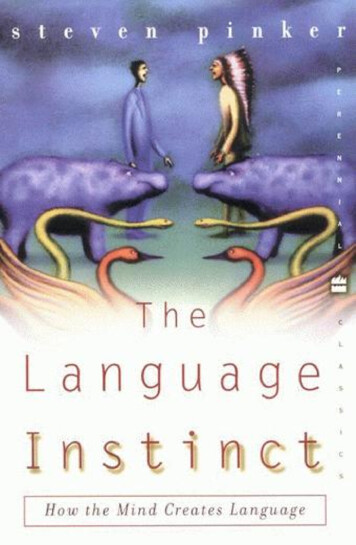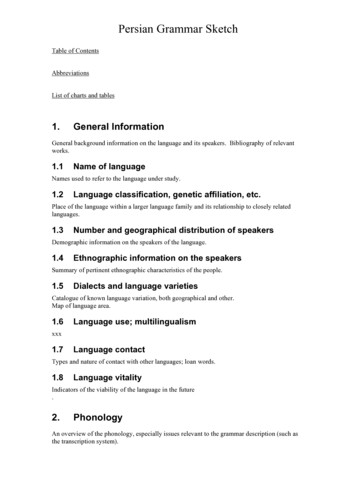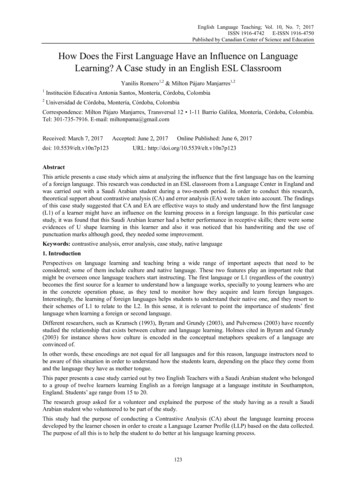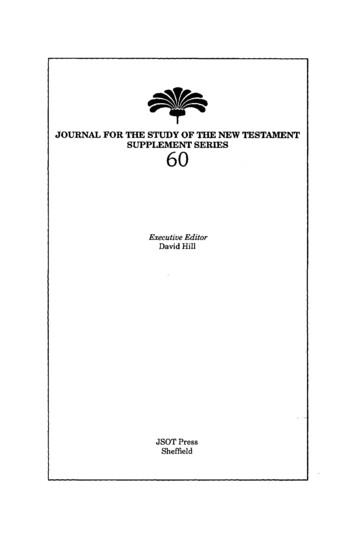
Transcription
JOURNAL F O RTHE STUDY O F THENEW TESTAMENTSUPPLEMENT SERIES60Executive EditorDavid HillJSOT PressSheffield
The Language of theNew TestamentClassic EssaysEdited byStanley E. PorterJournal for the Study of the New TestamentSupplement Series 60
CONTENTSPrefaceAbbreviations79IntroductionSTANLEY E. PORTERThe Greek of the New Testament as a Disputed Area of Research11ADOLF DEISSMANNHellenistic Greek with Special Consideration of theGreek Bible39JAMES HOPE MOULTONNew Testament Greek in the Light of Modern Discovery60CHARLES C. TORREYThe Aramaic of the Gospels98MATTHEW BLACKAramaic Studies and the Language of Jesus112JOSEPH A. FITZMYERThe Languages of Palestine in the First Century AD126HENRY S. GEHMANThe Hebraic Character of Septuagint Greek163NIGEL TURNERThe Language of Jesus and His Disciples174LARSNewOn theTestamentRYDBECKQuestion inoftheLinguisticContemporaryLevels Languageand the PlaceMilieuof the191
MOÏSES SILVABilingualism and the Character of Palestinian Greek205Index of ReferencesIndex of Authors227234
PREFACEThis anthology brings together a number of what I consider to beclassic essays regarding the Greek language of the NT; that is, whatkind of Greek is it: Semitic, koine, transitionary, and so on? Manypositions have been advocated, refuted, and debated. This gathering ofspokesmen is designed to give some idea of the history and progressof this continuing discussion.This collection of essays would not have been possible without theassistance of many people. Pride of position must go first to the distin guished contributors, many of whom are sadly now dead, but otherscontinue to discuss the topic raised by these essays. Although I do notknow many of them personally, through reading their many essays Icertainly feel I know them better than I did previously. More than thatI believe that I now have an idea of the kinds of questions which areuppermost in their minds and which have generated their interest andresponse. I am also impressed with the dedication and devotion theyhave displayed in their work on such an important topic, one whichhas a history of divisiveness and dissension. I would like also to thankall of the authors or their publishers who granted permission toreproduce the essays enclosed. To an individual, they were coopera tive, and in several instances especially encouraging that a collectionof this sort was necessary.In the second place I wish to thank my translators, Dr MarikaWalter and Dr Harold Biessmann, who took over the task ofrendering two previously untranslated essays into idiomatic English:Adolf Deissmann's 'Hellenistic Greek' and Lars Rydbeck's 'On theQuestion of Linguistic Levels and the Place of the New Testament inthe Contemporary Language Milieu'. The German was technical anddifficult, and the time-constraints I dare say unreasonable.In the third place I wish to thank my excellent typist, Miss MelodyVersoza. Quite frankly, I was astounded at the speed and accuracywith which she took these essays and brought them into conformitywith appropriate manuscript form.
In the fourth place I wish to thank two diligent reference librariansat Biola University's Rose Memorial Library: Mrs Beth Patton andMrs Sue Whitehead. In my furious and frantic attempt to fill out asmany bibliographical references as possible, they were equally dili gent and enthusiastic. Like sleuths groping for hidden clues, they didnot give up until every last reference was exhausted. The completenessof the notes in several of these essays is really their responsibility.In the fifth place I wish to thank my publisher, Professor DavidJ.A. Clines of the University of Sheffield, who encouraged me topublish this work when it was little more than an idea, and whoaccepted it as on-schedule whenever it came in. I wish the Press thebest of fortune in the years to come.Finally, I wish to thank and dedicate this collection of essays to myparents, Stanley E. and Lorraine D. Porter, who have been a constantand continual source of encouragement and help. For what its worth,the fact that I do what I do is in large measure their doing. For thisbook, they alone have helped to offset a good portion of the necessaryexpenses.In a day and age in which theology is often of paramount—evenexclusive—interest for those concerned with the biblical text, somehave given quizzical looks when I have mentioned that I have beenworking on areas of NT Greek grammar. But allow me to quote(a little out of context) James Hope Moulton, who to my mindcombined in an unparalleled way excellence in scholarship with truegreatness of character: 'But the practical advantages of confiningattention to what concerns the grammatical interpretation of a book ofunique importance, written in a language which has absolutely noother literature worthy of the name, need hardly be labored here, andthis foreword is already long enough' (Preface to second edition,Prolegomena, vol. 1 of A Grammar of NT Greek [Edinburgh: T. & T.Clark, 3rd edn, 1908] xiv). Now you know my position.
sArbeiten zur Geschichte des antiken Judentums und desUrchristentumsAmerican Journal of TheologyAufstieg und Niedergang der römischen WeltArchiv orientalniAnnual of the Swedish Theological InstituteBulletin of the American Schools of Oriental ResearchBiblicaBulletin of the Israel Exploration Society ( Yediot)Bulletin of the John Rylands University Library of ManchesterThe Bible TranslatorBible et terre sainteBeiträge zur Wissenschaft vom Alten TestamentCatholic Biblical QuarterlyCorpus inscriptionum iudaicarumCorpus inscriptionum latinarumCompendia rerum iudaicarum ad Novum TestamentumDictionnaire de la Bible, SupplémentDiscoveries in the Judaean DesertEncyclopaedia Judaica (1971)J.A. Fitzmyer, Essays on the Semitic Background of the NTEstudios biblicosEvangelical QuarterlyExpository TimesGriechische christliche SchriftstellerHeythrop JournalΕ. Schürer (ed.), History of the Jewish People in the Age ofJesus ChristHandbuch zum Neuen TestamentHarvard Theological ReviewHebrew Union College AnnualIrish Biblical StudiesG.A. Buttrick (ed.), Interpreter's Dictionary of the BibleIsrael Exploration JournalR. Hestrin (ed.), Inscriptions Reveal
RevQRGGRSRRSVSefSEGTGITynBulVTZAWZDPVZNWJournal asiatiqueJournal of the American Oriental SocietyJournal ofBiblical LiteratureJournal of Bible and ReligionJaarbencht. . . ex oriente luxJournal of Jewish StudiesJournal of Near Eastern StudiesS. Klein, Jädisch-palästinisch corpus inscriptionumJournal of the Palestine Oriental SocietyJewish Quarterly ReviewJournal for the Study of the New TestamentJournal of Theological StudiesH. Donner and W. Röllig, Kanaanäische und aramäischeInschriftenLoeb Classical LibraryMonatsschrift für Geschichte und Wissenschaft des JudentumsJ. Fitzmyer and D. Harrington (eds.), Manual of PalestinianAramaic TextsNovum TestamentumNovum Testamentum SupplementsC.K. Barrett (ed.), New Testament BackgroundNew Testament StudiesOrientis graeci inscriptiones selectaeOrientalia (Rome)Oudtestamentische StudienPalestine Exploration Fund, Quarterly StatementPalästina JahrbuchPauly-Wissowa, Real-Encyclopädie der classischenAltertumswissenschaftQuarterly of the Department of Antiquities in PalestineRevue bibliqueRevue des études juivesRevue de QumranReligion in Geschichte und GegenwartRecherches de science religieuseRevised Standard VersionSefaradSupplementum epigraphicum graecumK. Galling (ed.), Textbuch zur Geschichte IsraelsTyndale BulletinVetus TestamentunZeitschriftfür die alttestamentliche WissenschaftZeitschrift des deutschen Palästina-VereinsZeitschrift für die neutestamentliche Wissenschaft
INTRODUCTIONTHE GREEK OF THE NEW TESTAMENTAS A DISPUTED AREA OF RESEARCHStanley E. PorterSince the first significant studies of Semitic influence on the NTpublished in the mid-seventeenth century, there has not been a lack ofinterest in the Greek language found in the NT, although the issuesinvolved are diverse and not easily defined. The topic includes treat ment not only of the Greek found in the NT documents themselves,but of the languages current in first-century AD Palestine. The essaysin this collection address both of these questions because of their closedependence upon each other. The focus of this anthology is to presentthe major statements of the twentieth century regarding the kind ofGreek found in the Greek NT.Before describing these selections in more detail, however, twocaveats must be registered. First, any collection of essays reflects theidiosyncracies of its anthologizer. This collection attempts to presentessays which speak for the major movements within this debate duringthe last one hundred years. Although I have selected the spokesmenwho I believe should be represented, it is almost certain that someoneelse would have made a different selection. Second, it is not alwayspossible or even advisable to include the best-known statements. Con sequently, although I believe that I have included incisive statementsby some of the most significant authors on this topic, the major pieceby each one, especially if this piece is already widely available, is notalways included. I have tried to include complete statements, rather11. For recent summaries of the debate see E.C. Maloney, Semitic Interference inMarcan Syntax (Chico, CA: Scholars Press, 1981), pp. 7-34; and J.W. Voelz, 'TheLanguage of the NT', ANRW II.25.2 (ed. W. Haase; Berlin: de Gruyter, 1984),pp. 894-930.
than excerpts. The result is a collection of essays which, I trust, willbe broadly representative without being repetitious, inclusive but stilldefinably focused.The proposals regarding the nature of the Greek of the NT haveranged from positing a pure koine derived directly from Attic Greekto a heavily Semitized translation Greek, and all points in between.Whereas there has been significant work in this area for well over thenear one hundred years surveyed by this collection, many engaged inacademic biblical studies are unaware of even the major contours ofthe debate. The result is often uncritical acceptance of a positionwhich may not in fact be as well supported as some believe. Thosewho can recount the major positions of the last one hundred years areall too aware that consensus on its many topics is still lacking. It ishoped that this collection will serve both to provide a meaningfulhistorical context in which discussion can continue and to clarifythrough examination of the history of discussion which questions areworth pursuing further and which questions are best laid to rest. Thefootnotes in this chapter are used to list bibliographical informationfor important sources, as well as to illustrate where some of theobservations have been pursued by subsequent research. The literatureon this topic is so immense that only a representative selection ofmore general works can be presented (I have tried to cite Englisheditions where available).Discussion of the nature of the Greek of the NT must begin with thework of the German scholar Adolf Deissmann. Beginning with hisBibelstudien (1895) and Neue Bibelstudien (1897), translated intoEnglish in 1901, and continuing with his Licht vom Osten (1908),translated into English in 1910, Deissmann was one of the first tomake widely known the importance of the then recently-discovered121. I have placed this discussion within the larger framework of Greek grammar inmy Verbal Aspect in the Greek of the NT, with Reference to Tense and Mood (NewYork and Bern: Peter Lang, 1989). This introduction is dependent upon pp. 111-17,with my own assessment of the various positions on pp. 141-56.2. Bibelstudien (Marburg: El wert, 1895) and Neue Bibelstudien (Marburg:Elwert, 1897) were translated together as Bible Studies by A. Grieve (Edinburgh:T. & T. Clark, 1901) and Licht vom Osten (Tübingen: Mohr, 1908) was translatedas Light from the Ancient East by L.R.M. Strachan (London: Hodder andStoughton, 1910 [see Expositor, Seventh Series, 7 (1909), pp. 97-110, 208-24,352-57]); it went through several German and English editions.
Egyptian papyri, as well as the Greek inscriptions. Arguing againstthe views that NT Greek fulfilled classical standards or that it alongwith the Septuagint (LXX) was part of a 'Biblical' Greek inspired bythe Holy Spirit, Deissmann maintained that the Greek of the NT waspart of the body of Egyptian or popular Greek of the Hellenistic age.Recognizing the LXX as a translated document, he thereby discountedany 'written Semitic Greek' as ever being a spoken or literarylanguage. He recognized that certain portions of the Gospel materialwere translations of Aramaic into Greek, though he questioned theability to reconstruct a Vorlage (unlike the case of the LXX). MostHellenistic Jews, Deissmann maintained, knew Greek as a firstlanguage. Investigation of the NT documents must proceed, therefore,from their examination as philological artifacts, not of the literarylanguage of the time but of the vast body of Hellenistic Greek, before11. This has been a topic of continuing debate. Some have questioned the purity ofAlexandrian or Egyptian Greek, hence its validity as a standard for establishing thenature of Hellenistic Greek. One group has maintained that Alexandrian Greek cameunder Semitic (primarily Hebrew) influence because of the large Jewish population inthe region. The papyri then already had a Semitic cast, hence their closeness to NTGreek. See, e.g., G. Dalman, The Words of Jesus: Considered in the Light of PostBiblical Jewish Writings and the Aramaic Language (trans. D.M. Kay; Edinburgh:T. & T. Clark, 1902), p. 17; R.R. Ottley, A Handbook to the Septuagint (London:Methuen, 1920), p. 165; and J. Courtenay James, The Language of Palestine andAdjacent Regions (Edinburgh: T. & T. Clark, 1920), pp. 57-75. Another group hasargued that the Alexandrian Greek of the papyri was influenced by Egyptian Coptic,which is, according to this view, syntactically similar to the Semitic languages. Thiswould result in apparent linguistic similarities between NT Greek, influenced byAramaisms, and the papyri, influenced by Coptic. See L.-Th. Lefort, 'Pour unegrammaire des LXX', Muséon 41 (1928), pp. 152-60; J. Vergote, 'Grec Biblique',DBSup3 (ed. L. Pirot; Paris: Librairie Letouzey et Ane, 1938) cols. 1353-60;F. Gignac, A Grammar of the Greek Papyri of the Roman and Byzantine Periods(2 vols.; Milan: Istituto Editoriale Cisalpino, [1976], 1981), I, pp. 46-48; 'TheLanguage of the Non-Literary Greek Papyri', Proceedings of the TwelfthInternational Congress of Papyrology (ed. D.H. Samuel; Toronto: Hakkert, 1970);'The Papyri and the Greek Language', Yale Classical Studies 28 (1985), pp. 15758. S.-T. Teodorsson argues against these positions, claiming that no other kind ofGreek has ever been found in Egypt, thus there is no evidence of a previous 'pure'Greek, no evidence of the creolization process, and no evidence of this Greek beingconsidered to depart from the acceptable norms of Hellenistic Greek (The Phonologyof Ptolemaic Koine [Gothenburg: Acta Universitatis Gothoburgensis, 1977],pp. 25-35).
application of secondary tests as to their Semitic 'feel'. As can be seen,Deissmann was surprisingly advanced in his consideration of theproblems of multilingualism and linguistic development. Though helimited himself fairly exclusively to investigation of lexicographicalitems, Deissmann maintained almost inevitably that a lexical item ofthe NT could be paralleled in Hellenistic Greek.Rather than include a portion from one of his better-known works,including also his The Philology of the Greek Bible or New Light onthe NT from Records of the Graeco-Roman Period, the selectionincluded in this anthology is a complete article, 'Hellenistic Greek[Hellenistisches Griechisch]', translated into English for the first timefrom the well-known Realencyklopädie für protestantische Theologieund Kirche (1899). After dismissing several false definitions of theconcept of 'Hellenistic Greek', Deissmann settles on a definition of thelanguage in use from 300 BC to AD 600 as the commercial language ofthe time. This Greek represents the collective written and spokenGreek of the period. After tracing various theories regarding theorigin of this Greek, including the influence of the Attic dialect,Deissmann turns to particular features of the language. Deissmanndistinguishes the language of the LXX from the Greek of the NT. Heemphasizes that the clearest markers of the Hellenistic language occurin phonology and morphology, as well as vocabulary, where supposedNT meanings are shown to be characteristic of Hellenistic Greek.Deissmann admits that certain syntactical constructions appear uniqueto the Greek Bible, although he attributes many of these to restrictedinstances of translation Greek. He closes by raising the question ofwhether individual books of the NT reflect a more colloquial or liter ary kind of writing, claiming that the area requires furtherinvestigation. This wide-ranging essay reflects the major themessuggested by the debate over the nature of the Greek of the NT,handled with the fair-mindedness which was typical of Deissmann. Hedoes not draw back from admitting Semitic influence where he sees it,although he does not lose sight of what he perceives as the larger121. Trans. L.R.M. Strachan; London: Hodder and Stoughton, 1908 (see Exposi tor, Seventh Series, 4 [1907], pp. 289-302, 425-35, 506-20; 5 [1908], pp. 61-75)and Edinburgh: T. & T. Clark, 1907.2. Ed. A. Hauck; Leipzig: Hinrichs, 3rd edn, 1899, VII, pp. 627-39.
1linguistic milieu out of which the NT documents arose.Deissmann's theories were soon applied more widely to grammar,as well as the lexicon, by James Hope Moulton, the Cambridge andManchester scholar who was tragically killed in 1917 while crossingthe Mediterranean. Moulton wrote a series of articles in the ClassicalReview (1901, 1904) and Expositor (1901, 1903-1904, 1908-1909),his Prolegomena, vol. 1 of A Grammar of NT Greek (1906), asignificant portion of the Accidence and Word-Formation, vol. 2 of AGrammar of NT Greek (1929), as well as a number of lesser-knownbut still valuable pieces. The Science of Language and the Study ofthe NT, his inaugural lecture at Manchester University, and his 'NewTestament Greek in the Light of Modern Discovery' are not as wellknown as they deserve to be. After examining volumes of papyri,Moulton found numerous parallels to many NT lexical items andgrammatical constructions, some previously thought to be foreign toGreek. Recognizing the revolutionary character of Deissmann's dis coveries, as well as Albert Thumb's similar philological findings,2341. The original essay includes a one and a half page bibliography, which is notreproduced in this translation. For those interested in tracing research beforeDeissmann many of the works in the bibliography will prove helpful.2. The following list is only representative: J.H. Moulton, 'Grammatical Notesfrom the Papyri', Classical Review 15 (1901), pp. 31-39, 434-42; 18 (1904),pp. 106-12, 151-55; 'Characteristics of NT Greek', Expositor, Sixth Series, 9(1904), pp. 67-75, 215-25, 310-20, 359-68, 461-72; 10 (1904), pp. 24-34, 16874, 276-83, 353-64, 440-50; 'Notes from the Papyri', Expositor, Sixth Series, 3(1901), pp. 271-82; 7 (1903), pp. 104-21; 8 (1903), pp. 423-39 (many of hisarticles in Expositor 1908-1909 found their way into J.H. Moulton and G. Milligan,The Vocabulary of the Greek Testament Illustrated from the Papyri and Other NonLiterary Sources [London: Hodder and Stoughton, 1914-29]); An Introduction to theStudy of NT Greek (London: CH. Kelly, 2nd edn, 1903) (this edition reflects theview with which Moulton is associated, not the first edition of 1895); 'Language ofthe NT', Dictionary of the Bible (ed. J. Hastings; Edinburgh: T. & T. Clark, 1909),pp. 528-30; Prolegomena, vol. 1 of A Grammar of NT Greek (Edinburgh: T. & T.Clark, 3rd edn, 1908) (with appendixes); Accidence and Word-Formation, vol. 2 ofA Grammar of NT Greek, with W.F. Howard (Edinburgh: T. & T. Clark, 1929);From Egyptian Rubbish Heaps (London: CH. Kelly, 1916).3. Manchester: University Press, 1906, and Essays on Some Biblical Questionsof the Day: By Members of the University of Cambridge (London: Macmillan,1909), pp. 461-505 (reprinted in this volume).4. See, e.g., A. Thumb, Die griechische Sprache im Zeitalter des Hellenismus:Beiträge zur Geschichte und Beurteilung der ΚΟΙΝΗ (Strassburg: Trübner, 1901);
Moulton concludes that biblical Greek, 'except where it is translationGreek, was simply the vernacular of daily life', without 'serious'dialectical differences and very much a predominant language in thebilingual environment of Palestine.Moulton's selection, 'New Testament Greek in the Light of ModernDiscovery', from Essays on Some Biblical Questions of the Day: ByMembers of the University of Cambridge (1909), has been chosen forinclusion here. Moulton begins by noting the changes of standpoint instudy of NT Greek produced by comparative philology, the dis coveries of papyri and inscriptions, the growth of interest in dialectsof modern Greek, and the work of Thumb and Deissmann, as well asvarious opponents. Moulton argues for the homogeneity of theHellenistic vernacular as the lingua franca of the Greco-Roman world,and against Semitic influence. In the second part of the essay, heanalyses the various biblical writers. For example, he notes Luke'ssense of style and conscious assimilation to the LXX, Paul's restrictedyet significant contacts with Greek literature and philosophy, the liter ary quality of Hebrews, the artificial Greek of 2 Peter, the correctionsof Mark's Greek found in Matthew, the simple Greek of the Johanninewritings, interpretation of the odd Greek of the Apocalypse, and the(to him) obvious Aramaic background of Mark. Moulton concludes byrecognizing the value of the papyri for understanding the vocabularyof the NT, and bemoaning the deleterious influence of classical pre suppositions on the study of NT Greek. He pleads for recognition ofthe value of study of the Greek of the NT as a fitting introduction tothe world and language of the Roman Empire. Whereas Moultonclearly built upon the work of Deissmann and others, he was an inde pendent thinker in his own right, feeling free to suggest various placeswhere recent discoveries aided in understanding the Greek of the NT.He was a rare man in combining the demonstrated abilities of aclassical and comparative philologist, theologian and linguist. One canonly speculate about the greatness of his contribution had he livedlonger.12'Hellenistic and Biblical Greek', Dictionary of the Apostolic Church (ed. J. Hastings;Edinburgh: T. & T. Clark, 1915), I, pp. 551-60; 'On the Value of Modern Greekfor the Study of Ancient Greek', Classical Quarterly 8 (1914), pp. 181-205.1. Moulton, Prolegomena, pp. 4, 5.2. M. Reiser (Syntax und Stil des Markusevangeliums im Licht der hellenistischen
Deissmann and Moulton were followed in their major precepts bymany others, as discussion below illustrates. Others found significantfault, however, with the Deissmann-Moulton hypothesis. One of themajor theories to reject Deissmann and Moulton's conclusions, and a12Volksliteratur [Tübingen: Mohr {Siebeck}, 1984], p. 2) contends that after thedeaths of the significant advocates of the Greek language hypothesis—Moulton,Deissmann and Thum!)—the field was left open to those positing the Aramaichypothesis.1. Only a selection of names and representative works can be mentioned:H.St J. Thackeray, A Grammar of the OT in Greek According to the Septuagint, I(Cambridge: Cambridge University Press, 1909); L. Radermacher,Neutestamentliche Grammatik: Das Griechisch des NT im Zusammenhang mit derVolkssprache (Tübingen: Mohr [Siebeck], 1911); Α. T. Robertson, A Grammar ofthe Greek NT in the Light of Historical Research (New York: Hodder andStoughton, 1914); G. Milligan, 'The Grammar of the Greek NT', ExpTim 31(1919-20), pp. 420-24, and Here and There among the Papyri (London: Hodderand Stoughton, 1922); H.G. Meecham, Light from Ancient Letters: PrivateCorrespondence in the Non-Literary Papyri of Oxyrhynchus of the First FourCenturies, and its Bearing on NT Language and Thought (London: Allen andUnwin, 1923); E.J. Goodspeed, 'The Original Language of the NT', in NewChapters in NT Study (New York: Macmillan, 1937), pp. 127-68; E.C. Colwell,The Greek of the Fourth Gospel: A Study of its Aramaisms in the Light of HellenisticGreek (Chicago: University of Chicago Press, 1931) and 'The Greek Language', inIDB, II (Nashville: Abingdon Press, 1962), pp. 479-87; P.W. Costas, An Outlineof the History of the Greek Language, with Particular Emphasis on the Koine and theSubsequent Periods (Chicago: University of Chicago Press, 1936); H. Koester,Introduction to the NT, I (2 vols.; Philadelphia: Fortress Press, 1982), pp. 103-13;R. Browning, Medieval and Modern Greek (Cambridge: Cambridge UniversityPress, 2nd edn, 1983), ch. 1; G.H.R. Horsley, 'The Fiction of "Jewish Greek'",New Documents Illustrating Early Christianity. V. Linguistic Essays (New SouthRyde: Macquarie University, 1989), pp. 5-40, who provides a very competent anddetailed discussion of the major issues; and M. Silva (see below).2. Suggestive modifications of their position have been made. For example,W.F. Howard, who completed vol. 2 (Accidence and Word-Formation) ofMoulton's A Grammar of NT Greek, includes the appendix on Semitisms (pp. 41185); A.J. Malherbe (Social Aspects of Early Christianity [London: Louisiana StateUniversity Press, 1977; Philadelphia: Fortress Press, 2nd edn, 1983], pp. 31-59)emphasizes the range of literary accomplishment of the NT documents; andG.H.R. Horsley ('Koine or Atticism—A False Dichotomy?', in New DocumentsIllustrating Early Christianity, vol. 5, pp. 41-48) wants to ensure that Atticism as aphenomenon of Hellenistic Greek is given its due. The work of L. Rydbeck is tosome extent a modification of Moulton and Deissmann's position (see below).
theory with probably more support over the years—or at least moreargumentative force than most others—maintains that the Gospels andat least the first part of Acts, and possibly Revelation, are directlydependent upon some form of Semitic language, probably Aramaic.This theory has progressed in several stages. A serious weakness ofearly attempts by, for example, A. Meyer, J. Wellhausen, Ε. Nestle,G. Dalman and F. Blass was a failure to thoroughly support Aramaicreconstructions of the supposed original text. This shortcoming hasbeen well-documented, even by proponents of the theory. Later,armed with a wealth of supposed evidence on the basis of such criteriaas apparent mistranslations, ambiguity in the Aramaic text, and paral lels with the LXX, Charles C. Torrey, the Yale University scholar,argued vociferously that the Gospels, Acts 1-15, and Revelation wereearly translations from Aramaic originals. Rather than depicting thetranslators as bunglers, however, Torrey depicted, for example, theGospel 'writers' as pious men who did an admirable job of translationin an attempt to preserve 'the wording of the original text' (lviii),enabling reconstruction of the underlying original, though the finalGreek may be, in Torrey's own words, 'inexcusable' (liv) as idiomaticGreek. Torrey wrote a number of important works, beginning withhis now well-known early article in the C.H. Toy Festschrift, in whichhe responded directly to Moulton's work. He continued his work inarticles as well as several books: The Composition and Date of Acts,12341. A. Meyer, Jesu Muttersprache: Das galiläische Aramäisch in seiner Bedeutungfür die Erklärung der Reden Jesu und der Evangelien überhaupt (Freiburg: Mohr[Siebeck], 1896); J. Wellhausen, Einleitung in die drei ersten Evangelien (Berlin:Reimer, 1905) (in the 1st edition [pp. 7-43] he emphasizes the Semitic or Aramaicelement standing behind the Gospels, while in the 2nd edition [1911; pp. 7-32] heplaces slightly more stress on the Gospels as part of the koine); E. Nestle,Philologica Sacra: Bemerkungen über die Urgestalt der Evangelien undApostelgeschichte (Berlin: Reuther und Reichard, 1896); Dalman, The Words ofJesus (who recognizes this problem on pp. 43-71); F. Blass, Philology of theGospels (London: Macmillan, 1898).2. See, e.g., M. Wilcox, The Semitisms of Acts (Oxford: Clarendon Press,1965), pp. 1-12; idem, 'Semitisms in the NT', ANRW II.25.2, pp. 979-86 andesp. the work of M. Black (see below).3. 'The Translations Made from the Original Aramaic Gospels', in Studies in theHistory of Religions (FS C.H. Toy; ed. D.G. Lyon and G.F. Moore; New York:Macmillan, 1912), pp. 269-317.4. A few of Torrey's articles include: 'Fact and Fancy in the Theories Concerning
Our Translated Gospels: Some of the Evidence, The Apocalypse ofJohn, and The Four Gospels: A New Translation, in which hetranslated into English his reconstructed Aramaic text behind the fourGospels (the quotations above are taken from his instructive intro duction). Torrey was followed in many respects by such scholars asC F . Bumey, J.A. Montgomery, M. Burrows and J. de Zwaan.The article by Torrey included in this anthology, 'The Aramaic ofthe Gospels', appeared in the Journal of Biblical Literature (1942),and its representative stance makes it worthy of inclusion here.Although the article is a response directed at A.T. Olmstead, and mayappear both discursive and a little technical, it gives a good sense ofthe kind of argumentation made by his supporters and opponents and aclear summary of the approach which Torrey himself took. Torreyclaims first of all that much more Aramaic literature can be foundthan most suppose, including many documents translated into Greekfrom Aramaic originals. He discusses in some detail several
The Greek of the New Testament as a Disputed Area of Research 11 ADOLF DEISSMANN Hellenistic Greek with Special Consideration of the Greek Bible 39 JAMES HOPE MOULTON New Testament Greek in the Light of Modern Discovery 60 CHARLES C. TORREY The Aramaic of the Gospels 98 MATTHEW BLACK Aramaic Studies and the Language of Jesus 112 JOSEPH A. FITZMYER


